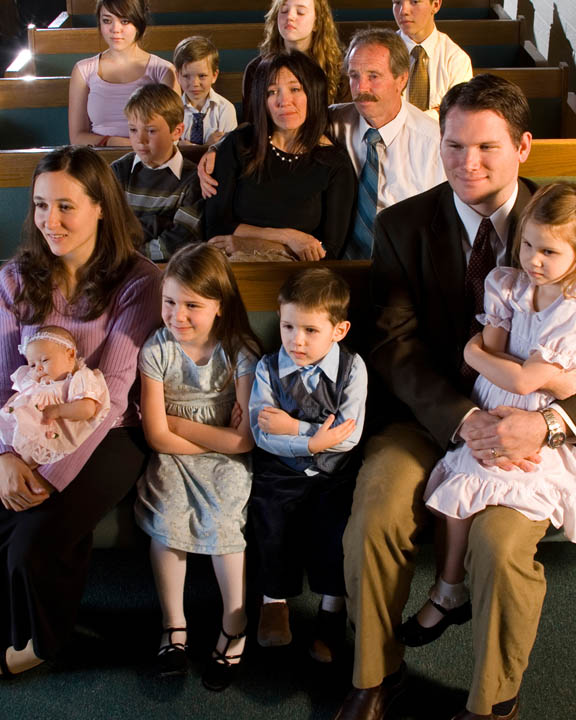 Today’s LDS family looks like most families in your community. If you were to spend the day with a local Mormon family, you’d see some things that are similar, and perhaps a few things that are different, but that you might find as appealing options in your own family.
Today’s LDS family looks like most families in your community. If you were to spend the day with a local Mormon family, you’d see some things that are similar, and perhaps a few things that are different, but that you might find as appealing options in your own family.
Here’s how typical LDS families spend the Sabbath, which is Sunday (in Christian countries, Saturday in Israel, Friday in Egypt).
Saturdays are busy days for most LDS families. The focus for Sunday is on keeping the Sabbath day holy, as we’ve been instructed in the Ten Commandments. For that reason, on Saturday, the family takes some time to clean the house, make basic meal preparations, select and clean clothes for the Sabbath, and do any other preparations that will leave them free to focus on the Savior the next day.
If all goes well—and since members of The Church of Jesus Christ of Latter-day Saints are mostly like anyone else, things don’t always go well—everyone is up and ready in time for a morning devotional and scripture reading, and a family breakfast before leaving for church. Church services are held in a meeting house. Meeting houses have a chapel, classrooms, offices, and a “cultural hall.”
Once there, the family goes together to Sacrament Meeting. Sacrament Meeting is the main church service, and the entire family attends together, even babies and small children. This can make for some noisy meetings, as little ones wiggle or giggle until they’ve learned how to behave, but members of the Church feel Sacrament Meeting should be a family experience. Parents work to teach their children to be reverent during meetings, and take out for a few minutes any child who is struggling to behave.
During this meeting, church business is handled. An opening hymn and prayer will be said. Any member of the Church might be asked to pray to open the meeting. The prayer is given in his or her own words. Then another song is sung, in preparation for the passing of the Sacrament, sometimes called Communion in other churches. In our church, this consists of bread and water, rather than wine.
A deacon is the first level of priesthood, obtained by worthy young men who are at least twelve years old. In the sacrament service, the deacons will pass the trays of bread and water to the congregation. The priests are sixteen or older. They bless the Sacrament, saying a prayer that is said in exactly the same way each time. While members sit in their seats and wait for the sacrament, they think about the Savior and His sacrifice made for them.
No collection plate is passed. Members of the Church pay their tithing privately by placing it in an envelope and giving it to one of three approved church leaders before or after meetings.
After the passing of the Sacrament, it’s time for the sermon. This often comes as a surprise to visitors. The Church is a lay church, and the pastor, called a bishop, can be any man who holds the priesthood. He has a regular job in the community of his own choosing and serves for around five years at a time in his church calling, without pay, and while continuing to be employed and to care for his family.
 The bishop doesn’t speak most weeks, although he or his two counselors (advisors and assistants) do conduct the meeting. Instead, any member of the Church age twelve or older can be asked to speak on a specific topic. Once a year, the younger children present the meeting, sharing what they’ve learned the past year in their classes. Typical topics might be the atonement, faith, the value of scriptures, or the importance of family. Generally, one teenager and two adults speak during the meeting, which then closes with a song and prayer.
The bishop doesn’t speak most weeks, although he or his two counselors (advisors and assistants) do conduct the meeting. Instead, any member of the Church age twelve or older can be asked to speak on a specific topic. Once a year, the younger children present the meeting, sharing what they’ve learned the past year in their classes. Typical topics might be the atonement, faith, the value of scriptures, or the importance of family. Generally, one teenager and two adults speak during the meeting, which then closes with a song and prayer.
After the Sacrament Meeting ends, family members move in different directions. Children who are eighteen months to three years go to a nursery, where they are cared for, but also taught brief lessons, given a snack, helped to play games and sing songs under the loving care of volunteers. Children ages 3-12 go to Primary, an organization just for children. During Sharing Time and Singing Time, they are in a large room called the Primary Room with children of a variety of ages. They learn simple gospel truths based on an annual theme. They have opening exercises here, and the children give the prayers, read a scripture, and give “talks” for their peers. This trains them to do it in the Sacrament meeting when they’re older. Even a three-year-old might give a talk, a miniature sermon, usually with a parent standing beside him or her, helping out.
Then they split into classes based on age and go to smaller rooms with a teacher. You can read the lessons they are taught at LDS.org.
The teenagers go first to Sunday School in mixed-gender classes divided by age, and then to gender specific Young Men’s and Young Women’s classes. In Sunday School, they study a specific book of scripture over the course of a year, alternating between Old Testament, New Testament, Book of Mormon, and Doctrine and Covenants. In the youth classes, they learn how to apply the gospel to their everyday lives.
The adults go first to a combined Sunday School, and then to gender-specific classes. Of course, many adults are working in one of the auxiliaries as teachers or leaders during this time. Since we’re a church with a lay clergy, once again, everyone is a volunteer. Both men and women have extensive opportunities to serve as leaders and teachers in the various programs of the Church.
After church, families spend their days quietly doing things that will bring them closer to the Savior or serve Him. They might work on their callings (church volunteer jobs), read scriptures, teach the gospel to small children or have a family council meeting. Only necessary tasks are accomplished and members avoid spending money that day. It is meant to be a day of spirituality and quietness.
